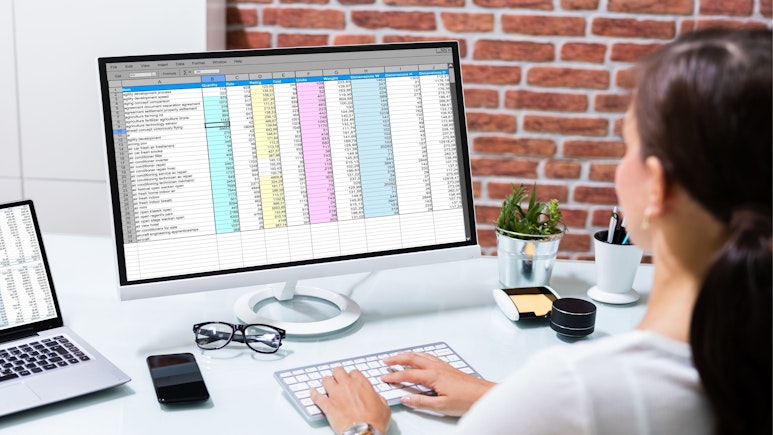Data Entry Tests (2026 Guide)
Updated November 20, 2023
What Is a Data Entry Test?
Data entry is the process of inputting any information into a database, word document or spreadsheet on a computer.
Data entry tests check the accuracy and speed at which a person can enter data.
They are used at interviews for positions where entering data is essential.
These might include:
- Medical clerks
- Secretaries
- Accountants
- 911 call-out responders
- Management consultants
- Admin assistants
Training for your data entry exam for online or offline data entry is crucial to increase your typing speed, accuracy and ability to stay calm and focused during the examination.
Depending on the role and the employer, pass marks required will be different.
Even state to state, 911 call-out center data entry tests have different pass marks.
Check which tests will be set and the pass marks with the employer in advance so you can practice.
Why Is Data Entry Important?
Data entry is important to businesses because documentation and information are often significant and critical to a company's performance.
For example, in real estate or law, contracts must be created, and mistakes can cause confusion and hinder or lose business deals.
Hospitals and schools must process significant amounts of data, often by transferring paper records to digital ones with precision and a thorough grasp of specialist jargon.
Entering data from audio without mistake is essential for customer care call centers or 911 responders.
A mistake in a hospital or 911 data entry could cost lives; therefore, the data entry speed tests for these roles are critical to securing the position.
Most consultancy firms use some form of data entry typing test in their interview process, including Accenture, Goldman Sachs, EY and PwC.
Data entry efficiency will be critical to the success of companies in the long run.
Practice Data Entry Test with JobTestPrep
What to Expect From Your Data Entry Test
Data entry tests come in a few different formats.
Data entry tests can involve testing a person's ability to cross-reference and confirm the accuracy of two data sets.
Some data entry tests will check how stress and time pressure affect a person’s accuracy and efficiency in data entry as part of a wider psychometric assessment.
Data entry typing tests can analyze several aspects of typing, from extracting information from audio or phone calls and entering it into databases, to accurate transcriptions of information from PDFs.
Depending on the company, tests might assess a person's ability to carry out the responsibilities of a certain position.
Many graduate schemes will have a data keystroke test included as a part of their psychometric testing process.
Common Types of Data Entry Speed Tests
Any task that involves entering information into a computer can be classed as data entry.
Different jobs demand different types of data entry, and so a wide variety of data entry typing tests are set in interviews.
Alphanumeric Data Entry
Alphanumeric data entry assessment tests check a candidate's ability to type numbers and letters into a computer without extra characters, spacing and formatting.
An alphanumeric data entry typing test will test a candidate's ability to enter numbers and letters from the keyboard, with 10 ten numbers across the top, as opposed to using the number pad to the right of the keyboard.
This type of data entry is commonly used in dispatcher exams, as entering alphanumeric data into address forms is a significant part of this work.
Numerical Data Entry
Numerical data entry typing tests measure a candidate's ability to enter data from the number pad at the right of the keyboard into spreadsheets.
This is a necessary ability in accounting, and it is frequently tested in data entry speed tests for bank clerks or other positions where properly inputting numbers will constitute the majority of an employee's daily activity.
Data Entry Keystroke Tests
Data entry keystroke tests specifically test the speed with which a person can enter data into a word document.
These tests measure a person's ability to input any form of data from a keyboard, including numbers, letters, symbols, spaces and tabs.
Content writers, bloggers and PR assistants will be expected to be able to write and present full documents accurately and with speed and give an employer a typing speed.
Therefore, these job interviews will often include a data entry keystroke test.
The 10 Key
10 Key data entry tests are similar to numerical data entry typing tests.
However, they focus on a candidate's ability to enter numbers accurately from the row of digits lying across the top of the keyboard.
This type of data entry speed test is usually set alongside an alphanumeric test or could be employed specifically to assess a candidate's ability to enter zip codes or phone numbers without mistakes.
If you need to prepare for a number of different employment tests and want to outsmart the competition, choose a Premium Membership from JobTestPrep.
You will get access to three PrepPacks of your choice, from a database that covers all the major test providers and employers and tailored profession packs.
Cross-Reference Testing
Cross-reference testing is a more complex form of data entry speed test.
In cross-referencing data entry tests, candidates have to check two tables of similar information against each other and make corrections or highlight discrepancies.
The largest data entry test providers tailor a subset of each type of test to the interviewer requesting them, and different types of data entry speed tests are used alongside each other to get a strong overview of an employee's data input skills.
What Are the Big Names in Data Entry Testing?
There are two major companies delivering data entry testing: CritiCall and Kenexa.
Kenexa Data Entry Speed Tests
Kenexa tests are used by most major accounting, consultancy, banking and management firms globally, including Morgan Stanley, Goldman Sachs, Accenture and PwC.
They deliver full psychometric tests that can be adjusted by each employer to evaluate the precise skills required for the role, and the data entry speed tests form part of these.
Kenexa is an IBM company that offers a portfolio of over 1,500 tests to global organizations.
Kenexa’s most popular data entry speed test is called ProveIT and includes two data entry speed tests.
The Kenexa Data Entry Alphanumeric Speed Test requires a candidate to type data from a PDF document into a simulation of a database.
There are five records to translate from text into data and eight fields per record.
The data is presented at the side of the screen, and candidates must transpose the data into the left-hand mock database, navigating between fields and records using the tab and enter keys on the keyboard.

The Kenexa Data Entry 10 Key test requires the testee to enter numbers into a simulation spreadsheet.
Again, there are five records with eight fields each.
This test only assesses how accurately and efficiently you can type numbers using the keys at the top of the keyboard.
Kenexa offers other broader evaluation data entry tests, such as the Kenexa Typing Test, the Kenexa Microsoft office tests and the Kenexa Accounting tests.
If you have been invited to take a Kenexa data entry test, it is likely to be tested alongside other data entry testing.
Different jobs require different pass scores; however, the minimum Keystroke per hour (Kph) rate for the Kenexa ProveIT alphanumeric test is 8,000 Kph, and the 10 Key data entry test is 10,000 Kph per hour.
The Kenexa data typing tests evaluate typing speed, elapsed time, field accuracy and accuracy percentage.
The KPH score is adjusted at the end of the test to accommodate for the mistakes made.
CritiCall Data Entry Tests
CritiCall data entry speed tests are used in interviews for roles in which candidates will have to type information accurately and under time pressure from phone calls.
These tests are primarily used in orientations for 911 dispatchers.
The CritiCall data entry typing tests emulate emergency calls.
The KPH score and accuracy score for the CritiCall tests include the time taken for clicking an option and selecting the appropriate emergency service to respond.
In this scenario, there is no opportunity for a candidate to ask for information to be repeated.
Therefore, they must be able to capture information accurately and efficiently at the first hearing.
The test is called a multitasking test because it evaluates the accuracy and efficiency of the data entry process and a candidate's ability to make decisions under pressure.
How to Practice for Your Data Entry Typing Test in 2025
There are many versions of data entry tests online and tools that will measure and help you improve your touch typing accuracy.
However, data entry speed tests are specific to different parts of the keyboard.
Practicing for general typing speed tests, therefore, may not be beneficial if you are set a specific type of data entry test.
It is best to practice specific data entry typing skills with targeted tools for that process.
For example, if you are training to be an accountant, practice using 10-keystroke test tools or number pad input tasks.
The most important factor in passing a data entry speed test is to complete it within the timeframe of the test.
Kenexa and CritiCall do not publish any practice materials themselves.
The best way to practice, therefore, is with full-length comprehensive model tests. The best model for the Kenexa practice test is via JobTestPrep.
The most comprehensive information about the CritiCall test can be found here: thepracticetest.com.
If you are not sure which test type your employer is setting you, ask in advance.
Many of the Kenexa data entry speed tests will form a part of a broader psychometric testing process.
Therefore, it may be worth paying for a package of practice tests that include other testing types, for example, aptitude tests.
Final Thoughts
The key to passing a data entry speed test is to stay calm, focused and be accurate.
Making small mistakes as you type will cost valuable seconds, and many data entry typing tests will adjust the KPH score to account for mistakes made.
It is worth starting slow, avoiding making mistakes as you practice, and getting a sense of your KPH at the start of your practice process.
From there, use typing training tools to raise your KPH score, and then move on to practice tests that emulate the full process with the time frame.
It is pointless to rush through your data input test only to make mistakes at the last minute.
Many of the tests last over an hour; therefore, learning to pace yourself as you type is also a part of the process.
As with most tests, it is important to get a good night's sleep in advance of the test, arrive early, and sit comfortably at the testing center desk to ensure your hands can move with ease and without causing injury.
It is important to get into healthy habits of pacing yourself and sitting with good posture if you are considering a career in data entry. This is good for your body and will make your movements more efficient, and shave valuable seconds from your data entry KPH score.
Stick to the comprehensive data entry typing practice tests, which cover all the types of data entry, and emulate the real exams.
This will ensure you are practicing for the test itself, not just improving your data entry skills.




